Ling Pei
RadarLLM: Empowering Large Language Models to Understand Human Motion from Millimeter-wave Point Cloud Sequence
Apr 14, 2025Abstract:Millimeter-wave radar provides a privacy-preserving solution for human motion analysis, yet its sparse point clouds pose significant challenges for semantic understanding. We present Radar-LLM, the first framework that leverages large language models (LLMs) for human motion understanding using millimeter-wave radar as the sensing modality. Our approach introduces two key innovations: (1) a motion-guided radar tokenizer based on our Aggregate VQ-VAE architecture that incorporates deformable body templates and masked trajectory modeling to encode spatiotemporal point clouds into compact semantic tokens, and (2) a radar-aware language model that establishes cross-modal alignment between radar and text in a shared embedding space. To address data scarcity, we introduce a physics-aware synthesis pipeline that generates realistic radar-text pairs from motion-text datasets. Extensive experiments demonstrate that Radar-LLM achieves state-of-the-art performance across both synthetic and real-world benchmarks, enabling accurate translation of millimeter-wave signals to natural language descriptions. This breakthrough facilitates comprehensive motion understanding in privacy-sensitive applications like healthcare and smart homes. We will release the full implementation to support further research on https://inowlzy.github.io/RadarLLM/.
Suite-IN++: A FlexiWear BodyNet Integrating Global and Local Motion Features from Apple Suite for Robust Inertial Navigation
Apr 01, 2025



Abstract:The proliferation of wearable technology has established multi-device ecosystems comprising smartphones, smartwatches, and headphones as critical enablers for ubiquitous pedestrian localization. However, traditional pedestrian dead reckoning (PDR) struggles with diverse motion modes, while data-driven methods, despite improving accuracy, often lack robustness due to their reliance on a single-device setup. Therefore, a promising solution is to fully leverage existing wearable devices to form a flexiwear bodynet for robust and accurate pedestrian localization. This paper presents Suite-IN++, a deep learning framework for flexiwear bodynet-based pedestrian localization. Suite-IN++ integrates motion data from wearable devices on different body parts, using contrastive learning to separate global and local motion features. It fuses global features based on the data reliability of each device to capture overall motion trends and employs an attention mechanism to uncover cross-device correlations in local features, extracting motion details helpful for accurate localization. To evaluate our method, we construct a real-life flexiwear bodynet dataset, incorporating Apple Suite (iPhone, Apple Watch, and AirPods) across diverse walking modes and device configurations. Experimental results demonstrate that Suite-IN++ achieves superior localization accuracy and robustness, significantly outperforming state-of-the-art models in real-life pedestrian tracking scenarios.
A2I-Calib: An Anti-noise Active Multi-IMU Spatial-temporal Calibration Framework for Legged Robots
Mar 10, 2025



Abstract:Recently, multi-node inertial measurement unit (IMU)-based odometry for legged robots has gained attention due to its cost-effectiveness, power efficiency, and high accuracy. However, the spatial and temporal misalignment between foot-end motion derived from forward kinematics and foot IMU measurements can introduce inconsistent constraints, resulting in odometry drift. Therefore, accurate spatial-temporal calibration is crucial for the multi-IMU systems. Although existing multi-IMU calibration methods have addressed passive single-rigid-body sensor calibration, they are inadequate for legged systems. This is due to the insufficient excitation from traditional gaits for calibration, and enlarged sensitivity to IMU noise during kinematic chain transformations. To address these challenges, we propose A$^2$I-Calib, an anti-noise active multi-IMU calibration framework enabling autonomous spatial-temporal calibration for arbitrary foot-mounted IMUs. Our A$^2$I-Calib includes: 1) an anti-noise trajectory generator leveraging a proposed basis function selection theorem to minimize the condition number in correlation analysis, thus reducing noise sensitivity, and 2) a reinforcement learning (RL)-based controller that ensures robust execution of calibration motions. Furthermore, A$^2$I-Calib is validated on simulation and real-world quadruped robot platforms with various multi-IMU settings, which demonstrates a significant reduction in noise sensitivity and calibration errors, thereby improving the overall multi-IMU odometry performance.
THE-SEAN: A Heart Rate Variation-Inspired Temporally High-Order Event-Based Visual Odometry with Self-Supervised Spiking Event Accumulation Networks
Mar 07, 2025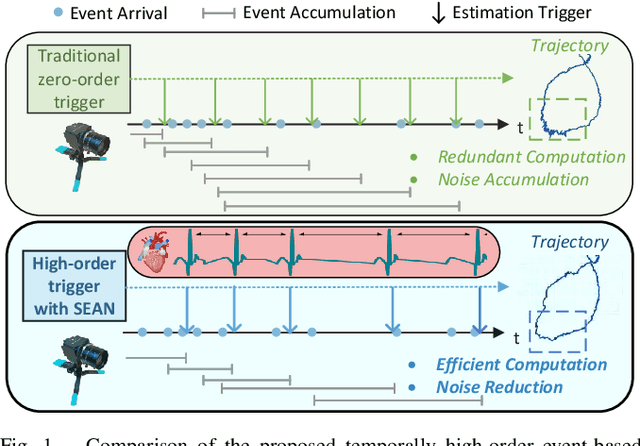
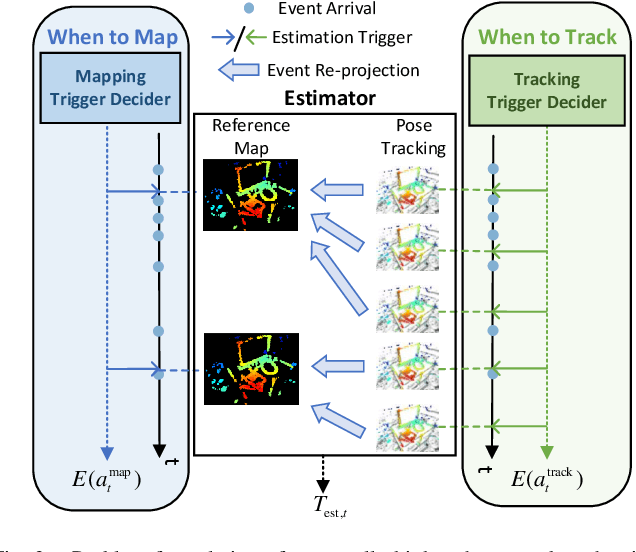

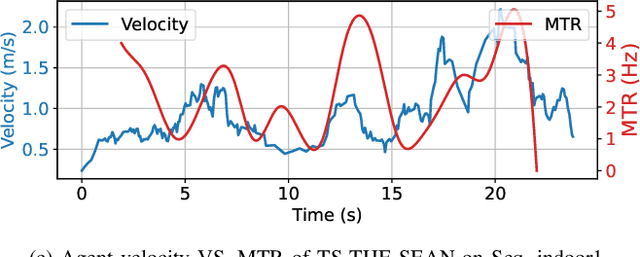
Abstract:Event-based visual odometry has recently gained attention for its high accuracy and real-time performance in fast-motion systems. Unlike traditional synchronous estimators that rely on constant-frequency (zero-order) triggers, event-based visual odometry can actively accumulate information to generate temporally high-order estimation triggers. However, existing methods primarily focus on adaptive event representation after estimation triggers, neglecting the decision-making process for efficient temporal triggering itself. This oversight leads to the computational redundancy and noise accumulation. In this paper, we introduce a temporally high-order event-based visual odometry with spiking event accumulation networks (THE-SEAN). To the best of our knowledge, it is the first event-based visual odometry capable of dynamically adjusting its estimation trigger decision in response to motion and environmental changes. Inspired by biological systems that regulate hormone secretion to modulate heart rate, a self-supervised spiking neural network is designed to generate estimation triggers. This spiking network extracts temporal features to produce triggers, with rewards based on block matching points and Fisher information matrix (FIM) trace acquired from the estimator itself. Finally, THE-SEAN is evaluated across several open datasets, thereby demonstrating average improvements of 13\% in estimation accuracy, 9\% in smoothness, and 38\% in triggering efficiency compared to the state-of-the-art methods.
mmDEAR: mmWave Point Cloud Density Enhancement for Accurate Human Body Reconstruction
Mar 04, 2025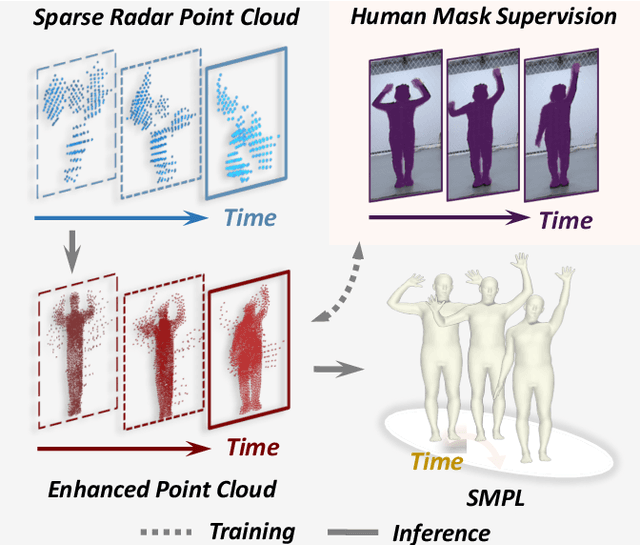

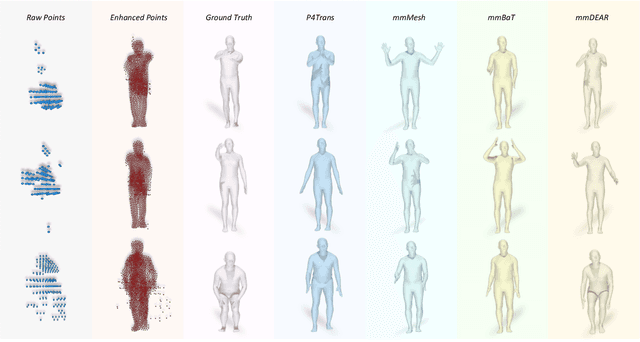

Abstract:Millimeter-wave (mmWave) radar offers robust sensing capabilities in diverse environments, making it a highly promising solution for human body reconstruction due to its privacy-friendly and non-intrusive nature. However, the significant sparsity of mmWave point clouds limits the estimation accuracy. To overcome this challenge, we propose a two-stage deep learning framework that enhances mmWave point clouds and improves human body reconstruction accuracy. Our method includes a mmWave point cloud enhancement module that densifies the raw data by leveraging temporal features and a multi-stage completion network, followed by a 2D-3D fusion module that extracts both 2D and 3D motion features to refine SMPL parameters. The mmWave point cloud enhancement module learns the detailed shape and posture information from 2D human masks in single-view images. However, image-based supervision is involved only during the training phase, and the inference relies solely on sparse point clouds to maintain privacy. Experiments on multiple datasets demonstrate that our approach outperforms state-of-the-art methods, with the enhanced point clouds further improving performance when integrated into existing models.
EnvPoser: Environment-aware Realistic Human Motion Estimation from Sparse Observations with Uncertainty Modeling
Dec 13, 2024



Abstract:Estimating full-body motion using the tracking signals of head and hands from VR devices holds great potential for various applications. However, the sparsity and unique distribution of observations present a significant challenge, resulting in an ill-posed problem with multiple feasible solutions (i.e., hypotheses). This amplifies uncertainty and ambiguity in full-body motion estimation, especially for the lower-body joints. Therefore, we propose a new method, EnvPoser, that employs a two-stage framework to perform full-body motion estimation using sparse tracking signals and pre-scanned environment from VR devices. EnvPoser models the multi-hypothesis nature of human motion through an uncertainty-aware estimation module in the first stage. In the second stage, we refine these multi-hypothesis estimates by integrating semantic and geometric environmental constraints, ensuring that the final motion estimation aligns realistically with both the environmental context and physical interactions. Qualitative and quantitative experiments on two public datasets demonstrate that our method achieves state-of-the-art performance, highlighting significant improvements in human motion estimation within motion-environment interaction scenarios.
360Recon: An Accurate Reconstruction Method Based on Depth Fusion from 360 Images
Nov 28, 2024



Abstract:360-degree images offer a significantly wider field of view compared to traditional pinhole cameras, enabling sparse sampling and dense 3D reconstruction in low-texture environments. This makes them crucial for applications in VR, AR, and related fields. However, the inherent distortion caused by the wide field of view affects feature extraction and matching, leading to geometric consistency issues in subsequent multi-view reconstruction. In this work, we propose 360Recon, an innovative MVS algorithm for ERP images. The proposed spherical feature extraction module effectively mitigates distortion effects, and by combining the constructed 3D cost volume with multi-scale enhanced features from ERP images, our approach achieves high-precision scene reconstruction while preserving local geometric consistency. Experimental results demonstrate that 360Recon achieves state-of-the-art performance and high efficiency in depth estimation and 3D reconstruction on existing public panoramic reconstruction datasets.
Spatiotemporal Decoupling for Efficient Vision-Based Occupancy Forecasting
Nov 21, 2024



Abstract:The task of occupancy forecasting (OCF) involves utilizing past and present perception data to predict future occupancy states of autonomous vehicle surrounding environments, which is critical for downstream tasks such as obstacle avoidance and path planning. Existing 3D OCF approaches struggle to predict plausible spatial details for movable objects and suffer from slow inference speeds due to neglecting the bias and uneven distribution of changing occupancy states in both space and time. In this paper, we propose a novel spatiotemporal decoupling vision-based paradigm to explicitly tackle the bias and achieve both effective and efficient 3D OCF. To tackle spatial bias in empty areas, we introduce a novel spatial representation that decouples the conventional dense 3D format into 2D bird's-eye view (BEV) occupancy with corresponding height values, enabling 3D OCF derived only from 2D predictions thus enhancing efficiency. To reduce temporal bias on static voxels, we design temporal decoupling to improve end-to-end OCF by temporally associating instances via predicted flows. We develop an efficient multi-head network EfficientOCF to achieve 3D OCF with our devised spatiotemporally decoupled representation. A new metric, conditional IoU (C-IoU), is also introduced to provide a robust 3D OCF performance assessment, especially in datasets with missing or incomplete annotations. The experimental results demonstrate that EfficientOCF surpasses existing baseline methods on accuracy and efficiency, achieving state-of-the-art performance with a fast inference time of 82.33ms with a single GPU. Our code will be released as open source.
Suite-IN: Aggregating Motion Features from Apple Suite for Robust Inertial Navigation
Nov 12, 2024



Abstract:With the rapid development of wearable technology, devices like smartphones, smartwatches, and headphones equipped with IMUs have become essential for applications such as pedestrian positioning. However, traditional pedestrian dead reckoning (PDR) methods struggle with diverse motion patterns, while recent data-driven approaches, though improving accuracy, often lack robustness due to reliance on a single device.In our work, we attempt to enhance the positioning performance using the low-cost commodity IMUs embedded in the wearable devices. We propose a multi-device deep learning framework named Suite-IN, aggregating motion data from Apple Suite for inertial navigation. Motion data captured by sensors on different body parts contains both local and global motion information, making it essential to reduce the negative effects of localized movements and extract global motion representations from multiple devices.
IMOST: Incremental Memory Mechanism with Online Self-Supervision for Continual Traversability Learning
Sep 21, 2024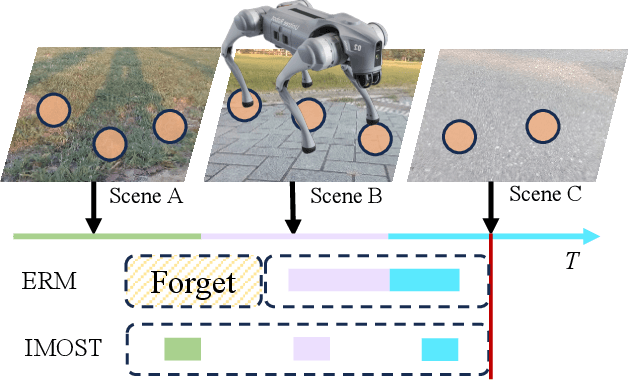
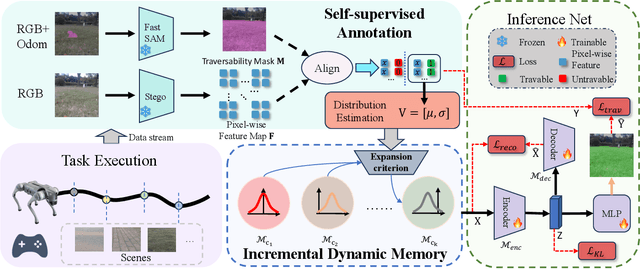
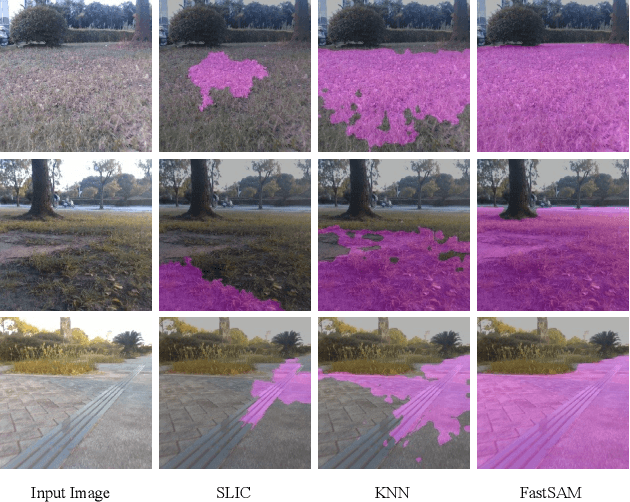

Abstract:Traversability estimation is the foundation of path planning for a general navigation system. However, complex and dynamic environments pose challenges for the latest methods using self-supervised learning (SSL) technique. Firstly, existing SSL-based methods generate sparse annotations lacking detailed boundary information. Secondly, their strategies focus on hard samples for rapid adaptation, leading to forgetting and biased predictions. In this work, we propose IMOST, a continual traversability learning framework composed of two key modules: incremental dynamic memory (IDM) and self-supervised annotation (SSA). By mimicking human memory mechanisms, IDM allocates novel data samples to new clusters according to information expansion criterion. It also updates clusters based on diversity rule, ensuring a representative characterization of new scene. This mechanism enhances scene-aware knowledge diversity while maintaining a compact memory capacity. The SSA module, integrating FastSAM, utilizes point prompts to generate complete annotations in real time which reduces training complexity. Furthermore, IMOST has been successfully deployed on the quadruped robot, with performance evaluated during the online learning process. Experimental results on both public and self-collected datasets demonstrate that our IMOST outperforms current state-of-the-art method, maintains robust recognition capabilities and adaptability across various scenarios. The code is available at https://github.com/SJTU-MKH/OCLTrav.
 Add to Chrome
Add to Chrome Add to Firefox
Add to Firefox Add to Edge
Add to Edge